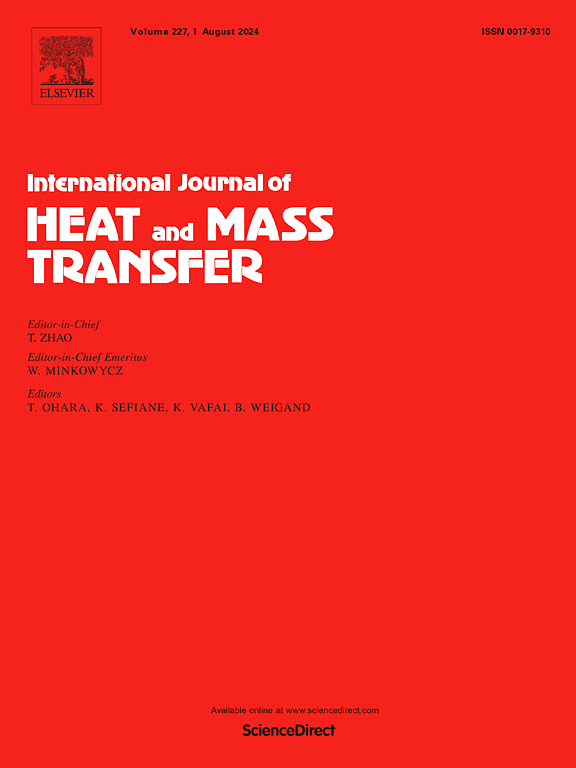真空和大气压条件下相变材料热管理模块性能的实验研究
IF 5.8
2区 工程技术
Q1 ENGINEERING, MECHANICAL
International Journal of Heat and Mass Transfer
Pub Date : 2024-11-08
DOI:10.1016/j.ijheatmasstransfer.2024.126384
引用次数: 0
摘要
现代电子设备的高计算能力和微型化导致了高发热量,而可用的散热面积减少又加剧了这一问题。由于缺乏对流,这一挑战在太空环境中更加严峻。相变材料(PCM)是卫星被动热管理的一个有力选择。然而,它们在真空中的表现尚不明确。本研究通过实验研究并比较了非 PCM 和 PCM 热控制模块在大气压和真空条件下的性能。使用印刷电路板(PCB)对带有内部平面散热片的不锈钢散热器进行了测试,以产生三个输入功率级别,模拟卫星电子设备的散热情况。石蜡被用作 PCM。报告和分析了两种压力条件下的热性能。建立了一个低阶数值模型,以较低的所需计算量预测性能。这项研究发现,在真空中工作的电子元件的温度比在大气中工作的电子元件的温度高出 32.8%,这是由于缺乏对流传热导致散热减少。此外,与大气压相比,PCM 对降低真空中电子元件温度的影响更大。6 克 PCM 可使真空中的电子元件温度降低 18.0 °C,使大气压下的电子元件温度降低 12.3 °C。在这两种压力条件下,PCM 的用量使电子元件在高功率下的工作时间延长了一倍。这项研究成果有助于了解非 PCM 和 PCM 散热器在不同压力条件下的性能差异,从而进一步改进卫星热管理模块的设计。本文章由计算机程序翻译,如有差异,请以英文原文为准。
Experimental investigation of the performance of a phase change material thermal management module under vacuum and atmospheric pressure conditions
High computational power and miniaturisation of modern electronics lead to high heat generation, compounded by the decreased available area for heat dissipation. This challenge is exacerbated in space environments due to the lack of convection. Phase change materials (PCM) are a strong option for the passive thermal management of satellites. However, their behaviour in vacuum is unclear. This study experimentally investigates and compares the performance of non-PCM and PCM-based thermal control modules under atmospheric pressure and vacuum conditions. A stainless steel heat sink with internal planar fins was tested using a printed circuit board (PCB) to produce three input power levels, simulating the heat dissipated by satellite electronics. Paraffin wax was used as the PCM. The thermal performance is reported and analysed for both pressure conditions. A reduced-order numerical model was established to predict performance with low required computational effort. This work finds that electronics operating in vacuum displayed temperatures as much as 32.8% higher compared to those in atmosphere due to decreased heat dissipation resulting from the lack of convective heat transfer. In addition, PCM had a greater impact in reducing the electronics temperature in vacuum than at atmospheric pressure. The presence of 6 g of PCM lowered the electronics temperatures by up to 18.0 °C in vacuum, and by up to 12.3 °C in atmospheric pressure. That amount of PCM doubled the electronics operating time under both pressure conditions at high power. The findings of this work contribute to understanding the performance variances of non-PCM and PCM-based heat sinks under different pressure conditions to further improve the design of thermal management modules for satellites.
求助全文
通过发布文献求助,成功后即可免费获取论文全文。
去求助
来源期刊
CiteScore
10.30
自引率
13.50%
发文量
1319
审稿时长
41 days
期刊介绍:
International Journal of Heat and Mass Transfer is the vehicle for the exchange of basic ideas in heat and mass transfer between research workers and engineers throughout the world. It focuses on both analytical and experimental research, with an emphasis on contributions which increase the basic understanding of transfer processes and their application to engineering problems.
Topics include:
-New methods of measuring and/or correlating transport-property data
-Energy engineering
-Environmental applications of heat and/or mass transfer

 求助内容:
求助内容: 应助结果提醒方式:
应助结果提醒方式:


